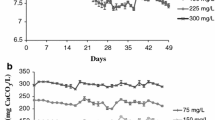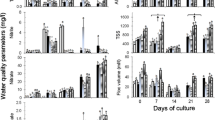Abstract
The present study aims to define the stocking density limits for each stage of Litopenaeus vannamei culture, considering that the system’s carrying capacity is able to maintain the water quality parameters at desired levels. This study was divided into four phases according to the size: phase 1, shrimp were stocked with initial weight of 0.002 g; phase 2, initial weight of 1.04 g; phase 3, initial weight of 6.09 g; and phase 4, initial weight of 12.51 g. Each phase lasted for 40 days, and the treatments applied were the different stocking densities. All stages were cultured in biofloc technology system (BFT). The results demonstrate that the shrimp stocking density affects the productive parameters, such as final weight, survival, apparent FCR, and yields for all the different phases. In addition, using a quadratic regression, the maximum stocking density for each tested phase was estimated. Also, the present study revealed that even with the ideal water quality parameters, the production was limited by the carrying capacity, which reached, e.g., 14 kg.m− 3 at phase 4.

Similar content being viewed by others
References
Aminot A, Chaussepied M (1983) Manuel des analyses chimiquesen milieu marin. Brest, CNEXO, 395p
APHA (2012) Standard methods for the examination of water and wastewater, 22nd edn. American Public Health Association, Washington DC
Arnold SJ, Sellars MJ, Crocos PJ, Coman GJ (2006) An evaluation of stocking density on the intensive production of juvenile brown tiger shrimp (Penaeus esculentus). Aquaculture 256:174–179. https://doi.org/10.1016/j.aquaculture.2006.01.032
Arnold SJ, Sellars MJ, Crocos PJ, Coman GJ (2006) Intensive production of juvenile tiger shrimp Penaeus monodon: an evaluation of stocking density and artificial substrates. Aquaculture 261:890–896. https://doi.org/10.1016/j.aquaculture.2006.07.036
Avnimelech Y (1999) Carbon/nitrogen ratio as a control element in aquaculture systems. Aquaculture 176:227–235. https://doi.org/10.1016/S0044-8486(99)00085-X
Avnimelech Y (2007) Feeding with microbial flocs by tilapia in minimal discharge bio-flocs technology ponds. Aquaculture 264:140–147. https://doi.org/10.1016/j.aquaculture.2006.11.025
Bendschneider K, Robinson RJ (1952) A new spectrophotometric method for the determination of nitrate in sea water. J Mar Res 11:87–96
Boyd CE (1989) Water quality management and aeration in shrimpfarming. In: Fisheries and Allied Aquaculture Department Series No. 2. Alabama Agriculture Experiment Station, Aubure University, Alabama
Braga A, Magalhães V, Hanson T et al (2016) The effects of feeding commercial feed formulated for semi-intensive systems on Litopenaeus vannamei production and its profitability in a hyper-intensive biofloc-dominated system. Aquac Rep 3:172–177. https://doi.org/10.1016/j.aqrep.2016.03.002
Browdy CL, Moss SM (2005) Shrimp culture in urban, super-intensive closed systems. In: Costa-Pierce B, Desbonnet A, Edwards P, Baker D (eds) Urban Aquaculture. Blackwell Science, CAB International, Oxford, pp 173–185
Chamberlain GW, Body A, Aungst R et al (2002) Partial harvesting: A smart strategy for shrimp farmers. Global Aquaculture Advocate, pp 1–10. 1st August 2002
Cohen JM, Samocha TM, Fox JM et al (2005) Characterization of water quality factors during intensive raceway production of juvenile Litopenaeus vannamei using limited discharge and biosecure management tools. Aquac Eng 32:425–442. https://doi.org/10.1016/j.aquaeng.2004.09.005
Correia ES, Wilkenfeld JS, Morris TC et al (2014) Intensive nursery production of the Pacific white shrimp Litopenaeus vannamei using two commercial feeds with high and low protein content in a biofloc-dominated system. Aquac Eng 59:48–54. https://doi.org/10.1016/j.aquaeng.2014.02.002
Da Silveira LGP, Krummenauer D, Poersch LH et al (2020) Hyperintensive stocking densities for Litopenaeus vannamei grow-out in biofloc technology culture system. J World Aquac Soc 51:1290–1300. https://doi.org/10.1111/jwas.12718
Da Silveira LGP, Krummenauer D, Poersch LH et al (2022) The effect of partial harvest on production and growth performance of Litopenaeus vannamei reared in biofloc technologic system. Aquaculture 546:737408. https://doi.org/10.1016/j.aquaculture.2021.737408
Deng Y, Xu X, Yin X, Lu H et al (2019) Effect of stock density on the microbial community in biofloc water and Pacific white shrimp (Litopenaeus vannamei) gut microbiota. Appl Microbiol Biotechnol 103(10):4241–4252
Ebeling JM, Timmons MB, Bisogni JJ (2006) Engineering analysis of the stoichiometry of photoautotrophic, autotrophic, and heterotrophic removal of ammonia-nitrogen in aquaculture systems. Aquaculture 257:346–358. https://doi.org/10.1016/j.aquaculture.2006.03.019
El-Sayed AFM (2020) Use of biofloc technology in shrimp aquaculture: a comprehensive review, with emphasis on the last decade. Rev Aquac :1–30. https://doi.org/10.1111/raq.12494
Emerenciano MGC, Martínez-Córdova LR, Martínez-Porchas M, Miranda-Baeza A (2017) Biofloc technology (BFT): a tool for water quality management in aquaculture. In: Water Quality. InTech, London, pp 91–109
Esparza-Leal HM, Cardozo AP, Wasielesky WJ (2015) Performance of Litopenaeus vannamei postlarvae reared in indoor nursery tanks at high stocking density in clear-water versus biofloc system. Aquac Eng 68:28–34. https://doi.org/10.1016/j.aquaeng.2015.07.004
FAO (2015) FAO and the 17 Sustainable Development Goals. Food and Agriculture Organization of the United Nations, Rome, Italy
FAO (2018) The State of World Fisheries and Aquaculture 2018 - meeting the sustainable development goals. Food and Agriculture Organization of the United Nations, Rome
FAO (2020) The state of world fisheries and aquaculture - sustainability in action. Food and Agriculture Organization of the United Nations, Rome
Fóes GK, Fróes C, Krummenauer D et al (2011) Nursery of pink shrimp Farfantepenaeus paulensis in biofloc technology culture system: Survival and growth at different stocking densities. J Shellfish Res 30:367–373. https://doi.org/10.2983/035.030.0224
Furtado PS, Poersch LH, Wasielesky WJ (2011) Effect of calcium hydroxide, carbonate and sodium bicarbonate on water quality and zootechnical performance of shrimp Litopenaeus vannamei reared in bio-flocs technology (BFT) systems. Aquaculture 321:130–135. https://doi.org/10.1016/j.aquaculture.2011.08.034
Furtado PS, Campos BR, Serra FP et al (2015) Effects of nitrate toxicity in the Pacific white shrimp, Litopenaeus vannamei, reared with biofloc technology (BFT). Aquac Int 23:315–327. https://doi.org/10.1007/s10499-014-9817-z
Gaona CAP, Serra FDP, Furtado PS et al (2016) Biofloc management with different flow rates for solids removal in the Litopenaeus vannamei BFT culture system. Aquac Int 24:1263–1275. https://doi.org/10.1007/s10499-016-9983-2
Jory DE, Cabrera TR, Dugger DM et al (2001) A global review of shrimp feed management: status and perspectives. In: Browdy CL, Jory DE (eds) The New Wave, Proceedings of the Special Session on Sustainable Shrimp Culture, Aquaculture. The World Aquaculture Society, Baton Rouge, pp 104–152
Krummenauer D, Peixoto S, Cavalli RO et al (2011) Superintensive culture of white shrimp, Litopenaeus vannamei, in a biofloc technology system in Southern Brazil at different stocking densities. J World Aquac Soc 42:726–733. https://doi.org/10.1111/j.1749-7345.2011.00507.x
Krummenauer D, Poersch LH, Fóes G et al (2016) Survival and growth of Litopenaeus vannamei reared in Bft System under different water depths. Aquaculture 465:94–99. https://doi.org/10.1016/j.aquaculture.2016.09.002
Moss K, Moss S (2004) Effects of artificial substrate and stocking density on the nursery production. J World Aquac Soc 35:536–542. https://doi.org/10.1111/j.1749-7345.2004.tb00121.x
Ponce-Palafox JT, Pavia ÁA, Mendoza López DG et al (2019) Response surface analysis of temperature-salinity interaction effects on water quality, growth and survival of shrimp Penaeus vannamei postlarvae raised in biofloc intensive nursery production. Aquaculture 503:312–321. https://doi.org/10.1016/j.aquaculture.2019.01.020
Qin H, Li Y (2014) The effects of stocking density and food on agonistic behavior and growth performance in Fenneropenaeus chinensis. Oceanologia et Limnologia Sinica/Hai Yang Yu Hu Chao 45(4):834–838
Quinn G, Keough M (2002) Experimental design and data analysis for biologists. Cambridge University Press, Cambridge
Rodríguez-Olague D, Ponce-Palafox JT, Castillo-Vargasmachuca SG et al (2021) Effect of nursery system and stocking density to produce juveniles of whiteleg shrimp Litopenaeus vannamei. Aquacult Rep 20:100709. https://doi.org/10.1016/j.aqrep.2021.100709
Samocha TM, Lawrence AL, Collins CA et al (2004) Production of the Pacific white shrimp, Litopenaeus vannamei, in high-density greenhouse-enclosed raceways using low salinity groundwater. J Appl Aquac 15(3–4):1–19. https://doi.org/10.1300/J028v15n03_01
Samocha TM, Patnaik S, Speed M et al (2007) Use of molasses as carbon source in limited discharge nursery and grow-out systems for Litopenaeus vannamei Aquac Eng 36:184–191. https://doi.org/10.1016/j.aquaeng.2006.10.004
Samocha TM, Wilkenfeld JS, Morris TC, Hanson T (2010) Intensive raceways without water exchange analyzed for white shrimp culture. Glob Aquac Advocate 13:22–24
Samocha TM, Prangnell DI, Hanson TR et al (2017) Design and operation of super-intensive, biofloc-dominated systems for the indoor production of Pacific white shrimp, Litopenaeus vannamei. The World Aquaculture Society, Baton Rouge
Sandifer PA, Hopkins JS, Stokes AD, Browdy CL (1993) Preliminary comparisons of the native Penaeus setiferus and Pacific P. vannamei white shrimp for pond culture in South Carolina, USA. J World Aquac Soc 24:295–303. https://doi.org/10.1111/j.1749-7345.1993.tb00161.x
Strickland JDH, Parsons TR (1972) A Pratical Handbook of Seawater Analysis. Fisheries Research Board of Canada Bulletin, 2nd edn , No. 167. Ottawa
Su Z, Xu W, Shi H, He J (2020) Research progress on the cannibalistic behavior of Aquatic Animals and The Screening of Cannibalism-Preventing Shelters. Israeli J Aquac - Bamidgeh 17:1–15
Suita SM, Braga A, Ballester E et al (2016) Contribution of bioflocs to the culture of Litopenaeus vannamei post-larvae determined using stable isotopes. Aquac Int 24:1473–1487. https://doi.org/10.1007/s10499-016-0006-0
Taw N (2010) Biofloc Technology Expanding at White Shrimp Farms. Global Aquac Advoc 15:20–22
Taw N, Fuat H, Tarigan N, Sidabutar K (2008) Partial harvest-biofloc system promising for Pacific white shrimp. Glob Aquac Advocate 13:84–86
Timmons MB, Ebeling JM (2010) Recirculating aquaculture, 2nd edn. Cayuga Aqua Ventures, LLC, Ithaca, p 948
UNESCO (1983) Chemical Methods for use in marine environmental monitoring. Intergovernmental Oceanographic Commission. Manuals and Guides 12. UNESCO, Paris, p 53
Van Wyk P (1999) An economic development strategy for Florida: final report. In: Van Wyk P, Davis-Hodgkins M, Laramore R et al (eds) Farming marine shrimp in freshwater systems. Prepared by Harbor Branch Oceanographic Institution, vol 4520. Florida Department of Agriculture and Consumer Services, Contract No, pp 1–32
Wyban JA, Lee CS, Sato VT et al (1987) Effect of stocking density on shrimp growth rates in manure-fertilized ponds. Aquaculture 61:23–32. https://doi.org/10.1016/0044-8486(87)90334-6
Yu R, Leung PS, Bienfang P (2009) Modeling partial harvesting in intensive shrimp culture: a network-flow approach. Eur J Oper Res 193:262–271. https://doi.org/10.1016/j.ejor.2007.10.031
Acknowledgements
The authors are grateful for the financial support provided by the National Council for Scientific and Technological Development (CNPq), Foundation for Research Support of the State of Rio Grande do Sul (FAPERGS) and the Coordination for the Improvement of Higher Level Personnel (CAPES). W. Wasielesky Jr. and L. Poersch are researches fellow of the CNPq. Special thanks to GUABI Animal Nutrition and Health S.A. for donating the experimental commercial diets and Trevisan Equipamentos Agro-Industriais LTDA. for donating the experimental aeration systems.
Author information
Authors and Affiliations
Corresponding author
Additional information
Handling Editor: Mauricio Gustavo Coelho Emerenciano
Publisher’s note
Springer Nature remains neutral with regard to jurisdictional claims in published maps and institutional affiliations.
Rights and permissions
About this article
Cite this article
da Silveira, L.G.P., Rosas, V.T., Krummenauer, D. et al. Establishing the most productive stocking densities for each stage of a multi-phase shrimp culture in BFT system. Aquacult Int 30, 1889–1903 (2022). https://doi.org/10.1007/s10499-022-00879-7
Received:
Accepted:
Published:
Issue Date:
DOI: https://doi.org/10.1007/s10499-022-00879-7




